CHARLOTTE, N.C. — Cam Who?
First-year Carolina Panthers coach Matt Rhule said when he moved on from franchise-quarterback Cam Newton that Teddy Bridgewater was a better fit for what he wanted to do offensively.
Bridgewater, with some help from the best overall running back in the NFL in Christian McCaffrey, supported that premise in Sunday’s 34-30 loss to the Las Vegas Raiders with accuracy and efficiency that gave the Panthers a chance to win.
What failed Carolina was — as advertised — a young defense that will take time to grow into a unit that can win. That group played hard as Rhule demands but gave up too many yards and points for Bridgewater and company to overcome.
Everything you need this week:
• Full schedule » | Standings »
• Depth charts for every team »
• Transactions » | Injuries »
• Football Power Index rankings »
More NFL coverage »
The run defense, in particular, was porous at times, giving up 133 total yards a year after being one of the worst in that category.
Still, the offense was in position to win until a questionable fourth-and-1 call near midfield with two minutes left because of Bridgewater and McCaffrey.
Bridgewater completed 22 of 34 pass attempts for 270 yards and a touchdown with no interceptions. He also rushed four times for 26 yards.
Not spectacular like Newton when healthy, but more than adequate to win.
The only advantage Newton might have given Carolina was on the fourth-down call, when he was almost automatic gaining less than a yard.
McCaffrey was his usual stellar self once offensive coordinator Joe Brady went to him consistently starting late in the third quarter. He had 96 yards rushing and two touchdowns on 23 carries and three catches for 38 yards.
Everyone around Bridgewater and McCaffrey played well enough to win, too.
The defense just needs time to catch up.
Predictable: Carolina, with four rookies starting on defense, is just too young to win games against good offensive teams at this point. And the Raiders are only slightly better than a good offense.
Troubling trend: Joey Slye’s preseason was filled with inconsistency, one reason Kaare Vedvik was kept on the practice squad. Despite three first-half field goals, Slye missed an extra point, something that plagued him last season, when he missed four.
Biggest hole in the game plan: Not going to McCaffrey much early. McCaffrey had 10 touches with about five minutes left in the third quarter. He had 11 on the next drive and finished with 26. When McCaffrey got rolling, so did the offense. Rhule and Brady said McCaffrey would be the focal part of the offense, so why wasn’t he from the beginning?


